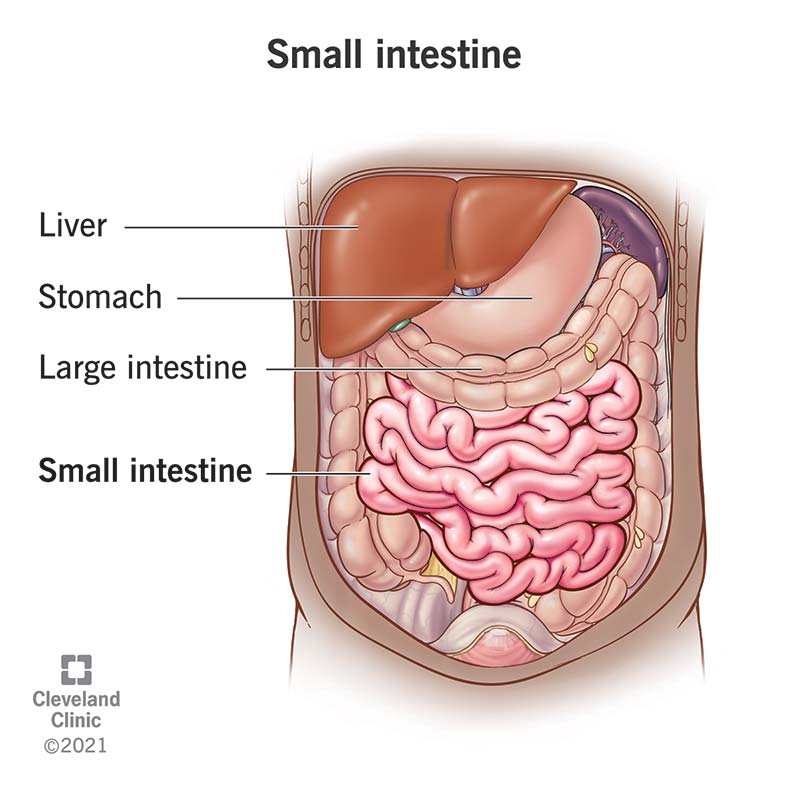Your small intestine (small bowel) is an organ in your gastrointestinal tract and is part of your digestive system. It breaks down food and fluid to absorb nutrients and water. More than 90% of the nutrients and water your body receives from food comes from the digestive process that your small intestine drives.
Advertisement
Cleveland Clinic is a non-profit academic medical center. Advertising on our site helps support our mission. We do not endorse non-Cleveland Clinic products or services. Policy

Your small intestine (small bowel) is an important part of your digestive system. It connects your stomach to your large intestine. You rely on your small intestine to extract nutrients from the food your eat. Your small intestine:
Advertisement
Cleveland Clinic is a non-profit academic medical center. Advertising on our site helps support our mission. We do not endorse non-Cleveland Clinic products or services. Policy
You may not have a reason to think about your small intestine as it churns through the continuous job of digesting what you eat and drink. But there are several common conditions and diseases that can affect small intestine function. Symptoms from them can make you feel miserable and disrupt your daily life. Understanding how your small intestine works can help you keep it in good shape and running smoothly.
Your small intestine turns semi-solid food into liquid so your body can absorb the nutrients you need. To do that, your small intestine:
Your small intestine is inside your abdominal cavity. It’s a long coil of tissues and muscle that looks like a very long, thin, pink or red tube with many folds. Your large intestine surrounds your small intestine.
Advertisement
Despite its name, your small intestine is the longest section of the gastrointestinal tract, measuring about 22 feet long.
Its inner lining is also impressively large, thanks to microvilli. These are the tiny, finger-like projections lining the wall of your small intestine. They increase the surface area that absorbs nutrients. (Think of shaking out a very large tarp with many folds and scrunched-up sections — in this case, the open tarp would cover a tennis court.)
The one small part of your small intestine is its width: it measures about 2 centimeters in diameter, or about as big around as your index (pointer) finger.
Your small intestine has three parts. Each part is responsible for specific tasks that are essential to digesting food. Those parts are:
This is the first part of your small intestine. It’s a short (10-inch-long) chute that receives food from your stomach. Your duodenum is the place where your small intestine makes the digestive juices and enzymes to break down food. Your gallbladder delivers bile, and your pancreas delivers digestive enzymes to your duodenum to help it break down food.
This section of your small intestine is 8 feet long. It lays in many coils inside the lower abdominal cavity. The jejunum is dark red because it has many blood vessels. It has muscles that churn food back and forth and mix it with digestive juices. Peristalsis, which is an involuntary muscle movement in your digestive system, keeps food moving toward your ileum.
This is the last and longest section of your small intestine. It absorbs nutrients from digested food for your body to use, like vitamins, minerals, carbohydrates, fats and protein. Your ileum moves food waste toward your large intestine. The ileum is where food spends the most time in the small intestine before moving to the large intestine.
There are many illnesses that can affect your small intestine. Some of the more common ones include:
Your small intestine absorbs nutrients and water from your food. Diseases and conditions that keep your small intestine from absorbing nutrients and water may cause the following symptoms:
A healthcare provider may order different tests depending on your symptoms. For example, if you’re losing weight without trying, a provider may order blood tests and other lab tests. If you have symptoms like belly pain, constipation or diarrhea, a healthcare provider may order tests that will let them see what’s going on inside your small intestine.
Advertisement
These tests may include:
These tests may include:
There are many conditions and diseases that can affect your small intestine and cause symptoms that disrupt your daily life. Treatments may range from making changes in what you eat to medication to surgery.
For example, if you have celiac disease, your treatment may be following a gluten-free diet. If you have peptic ulcer disease, a provider may prescribe medications that protect your small intestine while it heals. But if you have a small intestine obstruction, you may need surgery to remove the obstruction.
Taking care of your overall gut health is the best way to keep your small intestine healthy. Here are some suggestions:
Advertisement
There’s nothing small about the role your small intestine plays in supporting your overall health. It does the heavy lifting to break down the food that leaves your stomach, turning it into liquid nutrients. That heavy lifting takes time: food from one meal may spend up to six hours in your small intestine as it systematically breaks down that food. It also takes coordination with other organs in your digestive system.
Eating well and drinking lots of water can keep your small intestine healthy and on the job. So can contacting a healthcare provider when you have symptoms like belly pain, constipation, diarrhea or unexplainable weight loss. These symptoms may mean there’s something affecting your small intestine.
Advertisement
If you have issues with your digestive system, you need a team of experts you can trust. Our gastroenterology specialists at Cleveland Clinic can help.

Last reviewed on 10/14/2024.
Learn more about the Health Library and our editorial process.